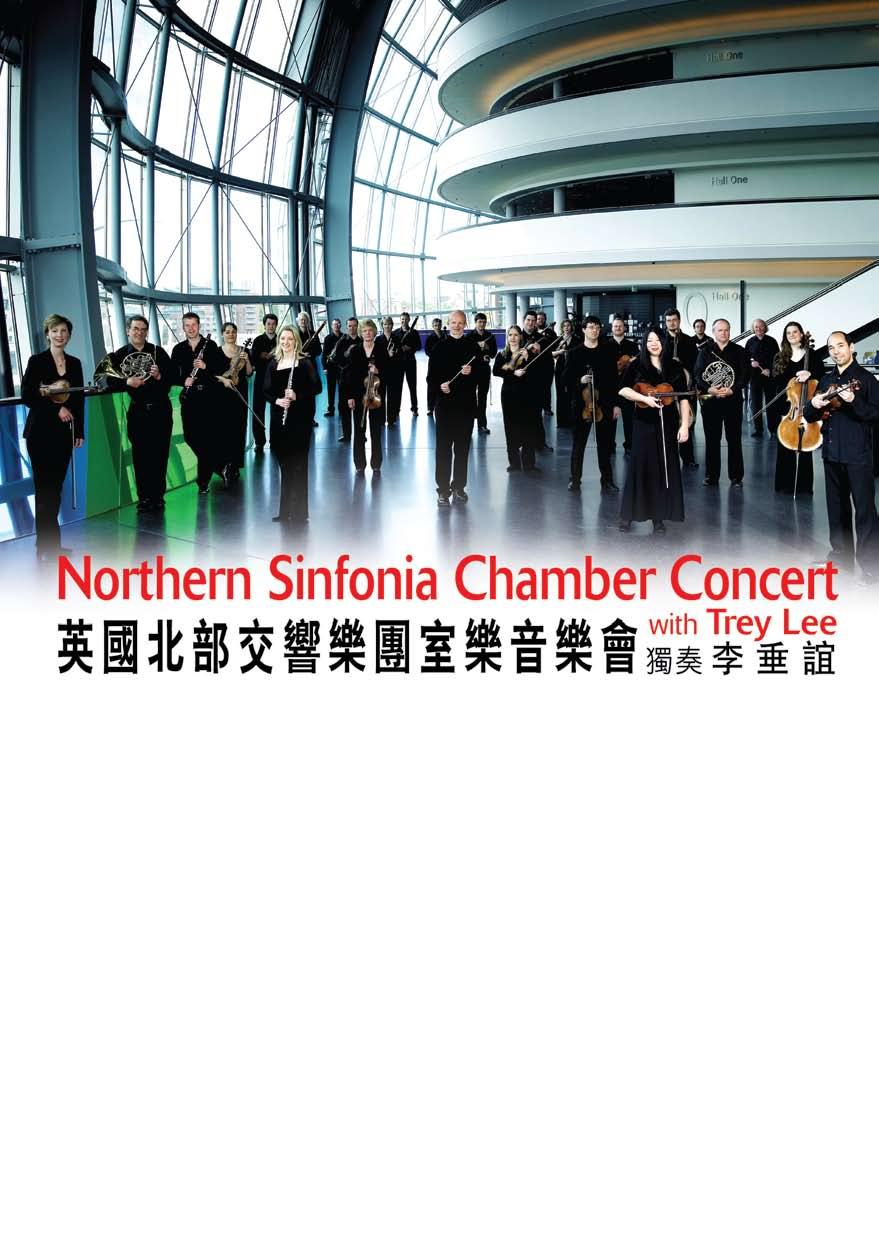

14.2.2009
元朗劇院演藝廳
Auditorium
Yuen Long Theatre
演出長約1小時,不設中場休息
Running time: approximately 1 hour with no interval
為了讓大家對這次演出留下美好的印象,請
切記在節目開始前關掉手錶、無綫電話及傳 呼機的響鬧裝置。會場內請勿擅自攝影、錄 音或錄影,亦不可飲食和吸煙,多謝合作。
To make this performance a pleasant experience for the artists and other members of the audience, PLEASE switch off your alarm watches, MOBILE PHONES and pagers. Eating and drinking, unauthorised photography and audio or video recording are forbidden in the auditorium. Thank you for your co-operation.
封面照片 Cover images:
樂團 Orchestra © Dan Brady
李垂誼 Trey Lee © Leo Yu (The Blue Hydrant)

07 曲目 Programme
09
英國北部交響樂團介紹 Northern Sinfonia Profile
簡歷 Biographies 11
李垂誼 Trey Lee
13 布拉德利.克雷齊克 Bradley Creswick
哈莉特.威廉斯 Harriet Williams
17
樂曲介紹 Programme Notes
24 歌詞 Lyrics
30 樂團成員 Orchestra List
英國北部交響樂團 Northern Sinfonia
英國北部交響樂團是歐洲享負盛名的 室樂團,在音樂總監湯馬士.薩赫米 亞帶領下,演奏曲目涵蓋西方古典音 樂,包括巴羅克、古典到浪漫時期作 品,也有委約新作。
2008年10月起,英國北部交響樂團慶 祝成立50周年。樂團除了進駐由名設 計師諾曼.科士打設計的蓋茲海德薩 茨音樂廳,也繼續巡迴世界各大場地 及藝術節,包括柏林愛樂音樂廳、阿 姆斯特丹皇家音樂廳、維也納金色大 廳、英國廣播公司逍遙音樂會、愛丁 堡藝術節及愛爾德堡音樂節。亞洲巡 演將以首爾和統營市為終站。
樂團也致力於錄音及廣播工作,演出 常於英國廣播公司轉播,並與古典 FM電台合作。樂團最近推出的唱片包 括廣受讚譽的巴赫及舒曼作品集,被 英國廣播公司《音樂雜誌》選為每月 最佳唱片。蓋茲海德薩茨音樂廳為樂 團出版了兩張唱片,其一是與鋼琴家 伊莫根.庫伯合作的專輯,收錄了莫 扎特第九鋼琴協奏曲《年青人》及第 二十三鋼琴協奏曲,獲《古典電台雜 誌》與《星期日郵報》五星評級。


Northern Sinfonia is one of Europe’s renowned chamber orchestras. Under its Music Director, Thomas Zehetmair, Northern Sinfonia's repertoire covers the full range of Western classical music from early Baroque, through the classical and romantic periods, to specially commissioned new work.
October 2008 marks the start of Northern Sinfonia’s 50th Anniversary Season. From its home at its own spectacular, Norman Foster-designed The Sage Gateshead, the orchestra continues to travel widely with regular appearances at other leading venues and festivals throughout the world including the Philharmonie Berlin, the Amsterdam Concertgebouw, the Musikverein in Vienna, the BBC Proms, the Edinburgh International Festival and the Aldeburgh Festival. Other performances in Seoul and Tong-yong will complete two Asian tours.
Recordings and broadcasts form an integral part of the orchestra's work. Northern Sinfonia is frequently broadcast by the BBC and also has a partnership with Classic FM. Recent recordings include the highly praised Brahms and Schumann CD chosen by BBC Music Magazine as “Disc of the Month”. The orchestra has released two CDs on The Sage Gateshead's own label. The first features Imogen Cooper as pianist in Mozart Piano Concertos No. 9, Jeunehomme, and No. 23, and has won five star reviews in Classic FM Magazine and The Sunday Telegraph.

李垂誼是當代傑出年青音樂家,於國 際楊尼格洛大提琴大賽中取得冠軍 後,成為世界矚目的新星。與指揮家 馬蓋在阿姆斯特丹皇家音樂廳的演 出,轟動西方音樂界,被《北荷蘭日 報》盛讚他為「巨星級音樂家」。
2009/2010年樂季,李垂誼將於歐亞 各地演出,包括與以色列交響樂團、 盧比克愛樂樂團及國立台灣交響樂團 的合作,以及在倫敦、柏林、赫爾辛 基、北京、上海及克羅地亞薩莫柏藝 術節舉行獨奏會。2009年6月,李垂 誼將帶領成立第一屆香港國際室內樂 音樂節,並擔任藝術總監。
李垂誼曾在各大音樂廳演出,包括 克里姆林宮、阿姆斯特丹皇家音樂 廳、馬德里國家演奏廳、芬蘭頌音樂 廳、日內瓦機動館、北京中山音樂堂 等。2007年7月,他與中國國家交響 樂團合作演出香港回歸十周年音樂 會。 其他合作過的樂團包括德國新威 斯特法倫、勃蘭登堡國家樂團、烏茲 堡愛樂樂團、芬蘭電台交響樂團、赫 爾辛基愛樂樂團、荷蘭愛樂樂團、斯 洛文尼亞愛樂樂團、塔比奧拉小交響 樂團、薩格勒布獨奏家樂團以及薩格 勒布愛樂樂團等。
李垂誼曾與百代音樂推出了幾張音樂 專輯,都為聽眾和樂評家所愛戴;國 際權威雜誌《留聲機》更稱讚李垂誼 為一個「奇積」。
李垂誼常於國際傳媒亮相,亦是香港 電台電視部製作的《華人青年音樂家》 系列主角之一。2007年,李垂誼榮獲 時尚人物大獎的年度音樂家大獎。
李垂誼是2009年香港藝術節瑞信新晉 藝術家。
Hailed by the North Holland Daily as “A Star Musician” in his performance with maestro Jun Markl at Concertgebouw, Trey Lee has been causing a sensation around the world since winning first prize at the International Antonio Janigro Competition.

In 2009/10, Lee will perform across Europe and Asia, including performances with the Israel Symphony Orchestra, Philharmonic Orchestra Lubeck, National Taiwan Symphony Orchestra, and recitals in London, Berlin, Helsinki, Beijing, Shanghai and at the Samobor Festival of Croatia. In June 2009, Lee will spearhead the first annual Hong Kong International Chamber Music Festival as its Artistic Director.
Lee has appeared in major venues and events including Moscow’s Kremlin, Madrid’s Auditorio Nacional, Helsinki’s Finlandia Hall, Geneva's Batiment des Forces Motrice, Forbidden City Concert Hall Beijing and the 10th Anniversary celebrations of the Hong Kong handover with the China National Philharmonic. Other orchestra engagements include the Philharmonics of Helsinki, the Netherlands, Slovania, Würzburg and Zagreb, the Symphonies of Finnish Radio, Neue Westfalen, Brandenburger State Orchestra, Tapiola Sinfonietta and Zagreb Soloists.
Lee collaborates with contemporary composers such as Bright Sheng and Stephen Hough, and has performed works by Penderecki and Lutoslawski to critical acclaim. His several albums recorded with EMI were enthusiastically received and Gramophone hailed him “A Miracle”.
Lee was featured in CNN and Financial Times, and was awarded 2007 Musician of the Year by Elle Style Award.
Lee is Credit Suisse Emerging Artist of 2009 Hong Kong Arts Festival.
領奏 Leader
早於1984年,布拉德利.克雷齊克首次 擔任英國北部交響樂團領奏,與樂團關 係悠久。
克雷齊克1987年移居倫敦帶領愛樂管弦 樂團,同時於英國北部交響樂團作客席 演出,包括1989年在英國廣播公司逍 遙音樂會擔任樂團獨奏,演出《雲雀高 飛》。克雷齊克在倫敦發展多年,擔任 皇家歌劇院樂團領奏,1994年重返英國 北部交響樂團。
克雷齊克最近兩度獲邀參加美國萬寶路 藝術節,並獲邀為不同樂團任客席領 奏。唱片作品包括與希考克斯合作的佛 漢.威廉斯作品《雲雀高飛》和《小提 琴協奏曲》;與馬爾科姆合作的韓德爾 大提琴協奏曲作品六;韓德爾的大協奏 曲作品三;與蘇黎世室樂團合作的莫扎 特小提琴及中提琴交響協奏曲。
Creswick
Bradley Creswick was appointed leader of Northern Sinfonia in 1984. In 1987 Creswick moved to London to lead the Philharmonia, however, he still maintained his relationship with the Northern Sinfonia, making guest appearances, notably as soloist in the 1989 BBC Proms playing The Lark Ascending. He became leader of the Orchestra of the Royal Opera House until 1994, when he returned to Northern Sinfonia.

Creswick has been invited twice to the Marlboro Music Festival in the US and is asked regularly to guest lead a wide range of orchestras. His recordings include: Vaughan Williams’s The Lark Ascending and Concerto Accademico with Richard Hickox on EMI; Handel Op. 6 Concerti Grossi with George Malcolm; Handel’s Concerti Grossi Op. 3 for Naxos; and the Sinfonia Concertante for Violin and Viola by Mozart with the Zurich Chamber Orchestra. 哈莉特.威廉斯
Mezzo-soprano
Harriet Williams
哈莉特.威廉斯於英國國立音樂與戲劇學 院畢業,並分別參加在林伯里工作室劇場 舉行,音樂大師芭芭拉.邦妮和托瑪斯. 艾倫爵士授課,以及在威格摩爾音樂廳舉 行,由布麗姬.法絲賓德授課的大師班。
威廉斯曾經演出的歌劇角色包括《波佩阿 的加冕》的奧塔維亞和命運女神,《費加羅 的婚禮》的凱魯比諾,《茶花女》的弗洛 亞以及《蝴蝶夫人》的鈴木。她曾與世界 著名的歌劇團合作,包括高文花園皇家歌 劇院、英國國家歌劇院、威爾斯國立歌劇 院、英國巡迴歌劇團、荷蘭公園歌劇團, 以及格蘭芝公園歌劇團等。
威廉斯合作過的指揮家包括奧特賴赫特、 哥連.戴維斯爵士、海廷克爵士、胡斯、 馬利納爵士、摩德斯、澤利格、列茲等; 合作演出的樂團包括聖馬丁室內樂團,皇 家利物浦愛樂樂團,以及皇家蘇格蘭國立 樂團等。
Harriet Williams studied at the Guildhall School of Music and Drama and took part in masterclasses with Barbara Bonney and Sir Thomas Allen at the Linbury Studio Theatre and with Brigitte Fassbaender at Wigmore Hall.
Williams’s operatic roles include Ottavia and Fortuna (L’incoronazione di Poppea), Cherubino (The Marriage of Figaro), Flora (La traviata) and Suzuki (Madama Butterfly). Among the opera companies she has appeared with are The Royal Opera, Covent Garden, English National Opera, Welsh National Opera, English Touring Opera, Opera Holland Park and Grange Park Opera.


Williams has performed under the baton of Petr Altrichter, Sir Colin Davis, Sir Bernard Haitink, Owain Arwel Hughes, Sir Neville Marriner, Christopher Moulds, Wolfgang Seeliger and Carlo Rizzi and with the Academy of St Martin in the Fields, the Royal Liverpool Philharmonic and the Royal Scottish National Orchestra.


窗,歐洲新音樂成為他尋找創作靈感 的路標;可是學院取向保守,布列頓 曾經要求圖書館購買一份荀伯格聯篇 歌曲《月宮小丑》的袖珍總譜作學習 之用,竟然也遭拒絕;學院亦不批准 他到維也納跟隨荀伯格的門生貝爾格 學習。
1932年,布列頓開始排練一首名為 《小交響曲》的作業,雖然作品出版 時有「作品1」的編號,卻絕非這位年 輕人的處女作。樂曲受荀伯格1906年 作品《第一室樂交響曲》所啟發,編 制包括十件樂器,對同是學生的演奏 者來說是一大挑戰;在拖拖拉拉的排 練過程中,室樂班的同學自然有來有 去,常令練習原地踏步,使布列頓苦 惱非常;這位19歲的音樂家在一次折 騰的練習後,在日記上寫道:「我重 未聽過這樣駭人的吵鬧聲!」
1933年1月,《小交響曲》和一些當 代的英國創作一起亮相,演出算中規 中矩,卻足已把布列頓送上光輝燦爛 的音樂之路,好幾位樂評稱讚作品 的創意,欣賞布列頓擺脫音樂傳統羈 絆的膽量;英國廣播公司一直留意着 這位樂壇新星,隨即向他委約一首新 作,開始了漫長而豐盛的合作關係。
在《小交響曲》中發展的素材都來自 開首的小節;上揚的號角呼喚,參考 荀伯格《第一室樂交響曲》近似的樂 段,呼號聲在好幾處都以不同形式重 現,在慢樂章的變奏,呼號由小提琴 接棒,發展成辛酸的歌曲,由低音弦 樂支持,展現出布列頓在塑造聲響質 感上的才華;在加快的步伐中,中提 琴帶領合奏進入一個動感的塔朗泰拉 舞曲,在興高采烈的氣氛中完結。
《紐卡素晚報》理查.葉茨 所寫之樂曲介紹
除特別註明,樂曲介紹:哈里.羅爾尼克 樂曲介紹中譯:黃家慧
students, he was looking to Europe for inspiration for compositions.
So stuffy was the RCM in those days that Britten’s request to its library to order a miniature score of Schoenberg’s song cycle “Pierrot Lunaire” to help him in his studies was rejected. It also refused him permission to study in Vienna with Alban Berg, the Austrian composer and disciple of Schoenberg.
However, in 1932 Britten was able to set up rehearsals of one of his college works, the Sinfonietta, which, although published as “Opus 1”, was by no means the first of the young man’s compositions. The work was for ten instruments and was very much inspired by Schoenberg’s first Chamber Symphony of 1906. It proved quite a challenge to the student musicians, and, as the rehearsals dragged on and, inevitably, members of the chamber music class came and went, it was often a case of back to square one for the frustrated Britten. “I have never heard such an appalling row!” the 19-year-old wrote in his diary after one particularly agonising session.
The Sinfonietta was eventually given a reasonably satisfying performance, alongside other contemporary English works, at a club outside the college in January 1933 but it was enough to put Britten on course to a glittering career. Several critics praised its inventiveness as well as Britten’s courageous independence from musical tradition, and, spurred by this response, the BBC which had for some time been watching his progress with interest commissioned a new piece from him, heralding the start of a long and fruitful partnership.
Much of the material developed in the Sinfonetta is taken from its opening bars. The rising horn call which pays homage to a similar passage in Schoenberg’s Chamber Symphony No. 1 recurs at various points, and in various forms, throughout the piece. In the Variations slow movement the call is taken up by the violins. This develops into a poignant song which is then supported by the lower strings, demonstrating Britten’s marvellous talent for contrasting sound textures. The pace then quickens and the viola leads the orchestra into a vigorous “Tarantella” for an exciting finish.
Programme notes by Richard C. Yates of the Newcastle Evening Chronicle
Unless otherwise specified, programme notes by Harry Rolnick
拉威爾
Maurice Ravel
Chanson Madécasses
馬達加斯卡之歌

Nahandove
Nahandove, ô belle Nahandove! L'oiseau nocturne a commencé ses cris, la pleine lune brille sur ma tête, et la rosée naissante humecte mes cheveux. Voici l'heure: qui peut t'arrêter, Nahahndove, ô belle Nahandove!
Le lit de feuilles est préparé; je l'ai parsemé de fleurs et d'herbes odoriférantes; il est digne de tes charmes. Nahandove, ô belle Nahandove!
Elle vient. J'ai reconnu la respiration précipitée que donne une marche rapide; j'entends le froissement de la pagne qui l'enveloppe; c'est elle, c'est Nahandove, la belle Nahandove!
Reprends haleine, ma jeune amie; repose-toi sur mes genoux. Que ton regard est enchanteur! Que le mouvement de ton sein est vif et délicieux sous la main qui le presse! Tu souris, Nahandove, ô belle Nahandove!
Tes baisers pénètrent jusqu'à l'âme; tes caresses brûlent tous mes sens; arrête, ou je vais mourir. Meurt-on de volupté, Nahandove, ô belle Nahandove?
Le plaisir passe comme un éclair. Ta douce haleine s'affaiblit, tes yeux humides se referment, ta tête se penche mollement, et tes transports s'éteignent dans la langueur. Jamais tu ne fus si belle, Nahandove, ô belle Nahandove!
Tu pars, et je vais languir dans les regrets et les désirs. Je languirai jusqu'au soir. Tu reviendras ce soir, Nahandove, ô belle Nahandove!

噢啊!
噢啊!噢啊!不要相信白人,
你們這些沿岸的住民! 在我們父親的日子, 白人來到島上。
有人告訴他們︰「這裏有些土地。」
你們的女人可以開墾這些土地 要公正、要仁愛。
並成為我們的兄弟。
白人們許下諾言,然而 他們築起戰壕。
修建攻擊的堡壘, 他們的銅炮 把雷電俘擄; 他們的牧師想給我們 一個我們不認識的上帝, 之後他們就談到服從與奴役。
寧可死掉!
大屠殺漫長而恐怖; 儘管他們可怖的雷電 把全軍覆沒, 他們還是被滅絕。
噢啊!噢啊!不要相信白人,
我們見到新暴君,
更強大更繁多,
在岸邊紮營,
天為我們而戰。
衪令雨水,風暴 和毒風降落他們頭上。
他們死掉,而我們活下來, 我們活得自由!
噢啊!噢啊!不要相信白人,
你們這些岸邊的住民!

Awa!
Awa! Awa! Do not trust the white men, you shore-dwellers!
In our fathers’ day, white men came to this island. “Here is some land,” they were told, “your women may cultivate it. Be just, be kind, and become our brothers.”
The whites promised, and all the while they were making entrenchments. They built a menacing fort, and they held thunder captive in brass cannon; their priests tried to give us a God we did not know; and later they spoke of obedience and slavery.
Death would be preferable! The carnage was long and terrible; but despite their vomiting thunder which crushed whole armies, they were all wiped out.
Awa! Awa! Do not trust the white men!
We saw new tyrants, stronger and more numerous, pitching tents on the shore. Heaven fought for us. It caused rain, tempests and poison winds to fall on them. They are dead, and we live, we live free!
Awa! Awa! Do not trust the white men, you shore-dwellers!
